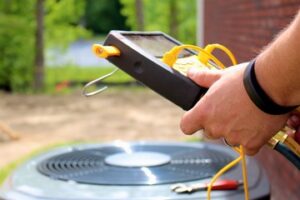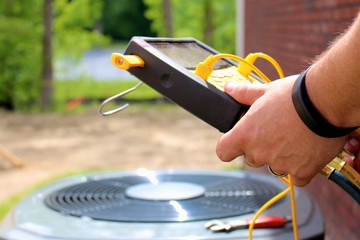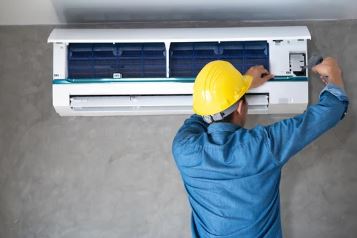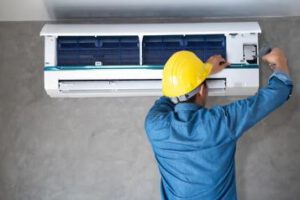HVAC systems keep indoor spaces livable by providing heat, ventilation, and air conditioning. They also reduce energy consumption and contribute to sustainable construction.
HVAC components include vents, ducts, and filters that transport air into and out of rooms. Thermostats regulate temperatures and offer programmable settings for convenience and energy efficiency. Read on Indoor Air Quality Naples FL for more information.
While heating and cooling are the most obvious aspects of a HVAC system, it is important to remember that ventilation and air purification play vital roles in maintaining good indoor air quality. The “V” in HVAC stands for ventilation, and it refers to the process of exchanging or replacing indoor air with outdoor air. This helps to improve and maintain indoor air quality by removing stale air, pollutants, odors, and excess moisture.
Ventilation systems are essential in both single-family homes and commercial buildings. These systems keep spaces warm during cold weather, removing stale air and reducing the risk of condensation. They also circulate fresh air, removing pollutants and odors and preventing the buildup of contaminants like dust, mold, bacteria, and carbon dioxide.
In fact, proper ventilation is the most critical part of your home’s heating and cooling system. A well-designed ventilation system should be able to meet your building’s recommended air change rate of.35 air changes per hour, or a minimum of 60 CFM of fresh air per square foot of living space.
However, while ventilation is an important part of the equation, it can also be problematic if not done properly. When your home is too humid, it can lead to the growth of mold and mildew which can be a health hazard for you and your family. It’s also possible for your home’s ductwork to become the collection point for these harmful substances, which will then be circulated throughout your entire house.
The best way to avoid this is by installing a high-efficiency particulate air (HEPA) filter which will trap particles and neutralize them to industry standards. These filters can be installed in your HVAC system and will help to prevent these contaminants from entering your home’s ductwork and circulating throughout your house.
It’s also a good idea to remove toxins from your home, such as paints, cleaning supplies, and other chemicals that can contaminate your air. This can be as simple as opening your windows to allow natural ventilation, which can often improve air quality more than an AC unit or a fan alone.
Humidity Control
As the winter weather approaches, building occupants may begin to experience discomfort due to low humidity levels. Low indoor humidity often leads to dry skin and throat problems for some people, but it also promotes the growth of mold, mildew, and other unhealthy organisms. This is why it’s so important to regulate air moisture with a humidification control system.
Humidity is typically measured in terms of relative humidity, which refers to how saturated the air is with water vapor based on its temperature. This measurement is more useful than absolute humidity, which measures the actual amount of water vapor in the air. Humidity control systems add or remove water vapor from the air to keep it within an optimal range. They can either be a standalone unit or integrated into the HVAC system itself. The most common method involves adding a dehumidifier or humidifier to the system’s ventilation path. This allows the system to control both the temperature and humidity in a single device.
If the relative humidity is too high, the HVAC system has to work harder to cool the air, leading to increased energy consumption. This can also lead to problems with the building envelope, which can lead to additional expenses and occupant discomfort. For this reason, it’s critical to install hygrometers in problem rooms and across the building to detect high moisture levels and take action.
The same applies for addressing low humidity levels. Low humidity creates the perfect environment for bacteria to thrive. These organisms can then spread through the building, leading to serious health concerns for occupants. These bacteria include dangerous gram-positive and gram-negative types. They are also known to release neurotoxic and pro-inflammatory substances, making them a threat to human health.
In addition, lower humidity levels allow dust mites to thrive. These microscopic creatures can cause allergies and aggravate conditions like eczema for sensitive occupants. They cling to a variety of materials, including clothing, pillows, and blankets, and reproduce quickly in humid conditions. They also produce waste, which can be aerosolized and circulated in the air, triggering allergic reactions in occupants. With proper humidity control, dust mite populations can be reduced to prevent them from causing discomfort and irritation.
Uneven Temperature Distribution
The indoor comforts that we enjoy in modern living spaces are made possible by heating, ventilation, and air conditioning (HVAC) systems. These are the cornerstones of our indoor environment, regulating temperature, air quality, and comfort. Unfortunately, uneven temperature distribution is a common problem that can compromise these goals and lead to discomfort in different parts of the space. Fortunately, professional HVAC services can pinpoint the causes of this issue and provide targeted solutions to resolve it.
A common cause of uneven heating is an improperly sized system. When a system is oversized, it may cool or heat an area too quickly without sufficient run time to reduce humidity and maintain ideal temperatures. An undersized system is also problematic, as it may struggle to maintain a comfortable climate, forcing it to run continuously, which leads to increased wear and tear and higher energy consumption. To prevent these issues, HVAC technicians should use the Manual J calculation to ensure that a system is properly sized for a given space.
Another common factor contributing to uneven heating is ductwork problems. If a home or business has a poorly designed or installed duct system, it may experience leaks that allow heated and cooled air to escape before reaching the rooms it is intended for. This can create cold spots and other problems that affect overall heating efficiency and comfort.
For homeowners, addressing uneven heating in the house is often a matter of changing thermostat settings or repositioning vents to better target specific rooms. This can be a simple fix, but it is important to understand how these changes impact other aspects of your indoor environment before making any significant adjustments.
For commercial buildings, uneven temperatures can negatively affect employee productivity and customer satisfaction and increase energy costs. Mastercraft Mechanical can diagnose and address these issues in commercial spaces throughout Haslet and the surrounding area, restoring comfort and efficiency while reducing energy costs. Contact us today to learn more about our comprehensive HVAC evaluations and how we can help you achieve a more consistent indoor environment.
Noisy HVAC Systems
While every HVAC system is likely to hum as it operates, unusual or louder-than-normal noises should be investigated by an expert. Some sounds are easy to diagnose and can be fixed with routine maintenance, while others may indicate a larger problem like loose or broken parts in the unit that need to be replaced. Whether you’re hearing clicking, rattling, hissing or clanking, these noises are all signs that something is amiss and should be addressed by a professional as soon as possible.
Loud thumping or banging sounds coming from your vents could be a sign that your ductwork is expanding or contracting and causing the metal to rub against other components. This is especially common in older homes or rooms with a lot of wooden surfaces, but even newer ducts can make this noise when air is moving through them. You can help eliminate this noise by insulating your ducts with fiberglass. This insulation is effective and inexpensive and can reduce duct noise by around 3 to 5 decibels.
Clicking sounds are more serious and can often be caused by a thermostat or other control that isn’t functioning correctly. A high-pitched hissing sound can also signal a refrigerant leak that is dangerous and needs to be repaired immediately.
A screeching sound can also indicate a problem with the motor fan or a belt that isn’t properly tightened. This is a serious issue that can cause damage to the motor and other internal components, so it’s important to get this fix as quickly as possible.
Lastly, a buzzing sound usually indicates that there are loose or damaged internal components in the unit. It’s important to have a technician check out your unit if you hear this noise, as it could indicate a problem with the capacitors or circuit board that will require replacement. It’s also a good idea to schedule regular maintenance appointments with your local HVAC company to keep track of any small problems before they turn into big ones. A little bit of maintenance can save you money in the long run by keeping your unit running smoothly and efficiently.


